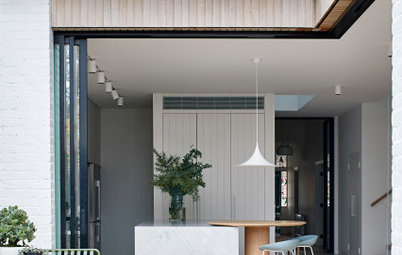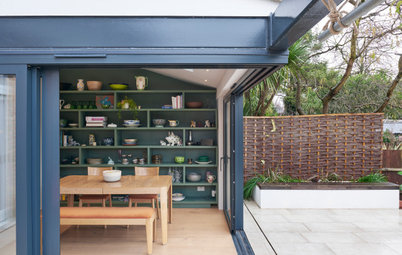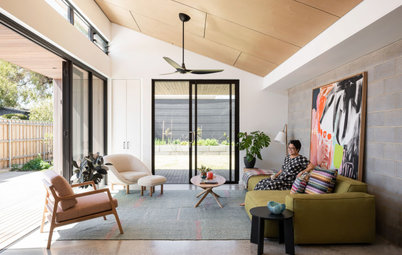Grand Designs' Kevin McCloud's Advice About Home Building
The TV presenter and architecture expert takes time out to share some pearls of house-building wisdom
We caught up with Grand Designs‘ Kevin McCloud for a chat about what it takes to get through a building project, ways to make period homes more energy-efficient, and self-parking slippers…
What’s the biggest mistake people make when embarking on building work?
It comes back again to that thing of not doing it alone. It’s not a solo journey – you need a support team and back-up. For most of us mere mortals, that means surrounding yourself with great people – good architects that provide you with detailed drawings, for example.
People often make the mistake of trying to do too much, which doesn’t work and is very painful to watch. Even Ben Law [one of the most popular Grand Designs builders who constructed his own timber home] had a great architect, friends and a lot of help from experts. Minimise hoofing it, and instead prepare, prepare, prepare.
It comes back again to that thing of not doing it alone. It’s not a solo journey – you need a support team and back-up. For most of us mere mortals, that means surrounding yourself with great people – good architects that provide you with detailed drawings, for example.
People often make the mistake of trying to do too much, which doesn’t work and is very painful to watch. Even Ben Law [one of the most popular Grand Designs builders who constructed his own timber home] had a great architect, friends and a lot of help from experts. Minimise hoofing it, and instead prepare, prepare, prepare.
What differences do you see now in the way people are building their homes in comparison to 10 years ago?
A decade ago was 2008, which marked the end of the glorious boom years when ‘bling’ was the big word. We then went into a slump, and in fact there’s nothing like a recession to force people to consider what they’re doing. We’ve seen people being resourceful, relying on their ingenuity and thinking their way out of a hole.
Domestic architecture, as you’d expect 18 years into the century, is now finding its feet and not digesting so many ideas from the previous century. We do still re-digest things – brutalism, for example – but in truth we’re moving towards something very much this century. I’m still not sure what it is, but I think it’s something I’ve been championing for a long time, which is trying to make buildings ‘of their place’.
Sustainable Design: Lessons We Can Learn From Vernacular Housing
A decade ago was 2008, which marked the end of the glorious boom years when ‘bling’ was the big word. We then went into a slump, and in fact there’s nothing like a recession to force people to consider what they’re doing. We’ve seen people being resourceful, relying on their ingenuity and thinking their way out of a hole.
Domestic architecture, as you’d expect 18 years into the century, is now finding its feet and not digesting so many ideas from the previous century. We do still re-digest things – brutalism, for example – but in truth we’re moving towards something very much this century. I’m still not sure what it is, but I think it’s something I’ve been championing for a long time, which is trying to make buildings ‘of their place’.
Sustainable Design: Lessons We Can Learn From Vernacular Housing
The architect Kenneth Frampton called it Critical Regionalism, which is a posh term for making stuff look like it belongs where it is. The last three RIBA House of the Year winners have all had powerful roots in their materials and where they are. Flint House [2015’s winner, pictured], for example, looks as if it was taken out of the ground, and is clad in local materials.
Have you seen any key architectural trends in 2018 that would translate into smaller renovation projects?
Ha, the Dutch architect Rem Koolhaas once said there’s no point trying to follow trends in architecture, because it takes so long to get through the planning process, it’ll be out of fashion by the time you actually build it! However, we do notice the same things emerging as we move around looking at building projects.
As far as I can see, the exciting new trends are high-tech ones – making our homes comfortable and easy to live in. I recently read about the invention of ‘self-parking slippers’ – when you kick them off anywhere in the home, they’ll take themselves back to their parking spot.
I’m still waiting for someone to invent a key fob like the ones we use for even the most basic of cars – one that opens the door with the press of a button, and will even put the hall light on to welcome you home.
Ha, the Dutch architect Rem Koolhaas once said there’s no point trying to follow trends in architecture, because it takes so long to get through the planning process, it’ll be out of fashion by the time you actually build it! However, we do notice the same things emerging as we move around looking at building projects.
As far as I can see, the exciting new trends are high-tech ones – making our homes comfortable and easy to live in. I recently read about the invention of ‘self-parking slippers’ – when you kick them off anywhere in the home, they’ll take themselves back to their parking spot.
I’m still waiting for someone to invent a key fob like the ones we use for even the most basic of cars – one that opens the door with the press of a button, and will even put the hall light on to welcome you home.
Are people embracing sustainable homes more now?
Yes. I think it’s really interesting. The green initiatives the [UK] government had in place 10 years ago have been replaced with a big interest in air quality and health, but we’re still following more and more Passivhaus construction and green housebuilding.
It’s not a fad, and I think people see what goes into a building project and want to find ways to make it more efficient. I think people understand the need for cheaper running costs, and perhaps say to themselves, “I have an opportunity not only to make something beautiful, but to have a home that doesn’t waste energy and could save me money”.
The 5 Principles of Passivhaus Design
Yes. I think it’s really interesting. The green initiatives the [UK] government had in place 10 years ago have been replaced with a big interest in air quality and health, but we’re still following more and more Passivhaus construction and green housebuilding.
It’s not a fad, and I think people see what goes into a building project and want to find ways to make it more efficient. I think people understand the need for cheaper running costs, and perhaps say to themselves, “I have an opportunity not only to make something beautiful, but to have a home that doesn’t waste energy and could save me money”.
The 5 Principles of Passivhaus Design
What’s your best advice for owners of a Victorian terrace who want to make their homes more efficient?
There’s a really great document called Warmer Bath that was produced by the Bath Preservation Trust [in the UK]. You can download it and it will guide you through all those things like secondary glazing and extra insulation. The thing to remember, though, is that the more you make an old building airtight, the more you need to think about ventilation and air quality. Ventilation is a key part of how old buildings work – it’s important to find ways to let the building breathe.
I’d also recommend a couple of fantastic books. One is New Design for Old Buildings by Roger Hunt and Iain Boyd, and the other is Old House Eco Handbook by Marianne Suhr and Roger Hunt.
Tell us
Do you ever dream of building your own home? Or do you like to take ideas from those larger projects for your own smaller renovations? Share your thoughts and ideas in the Comments section.
More
Read more stories about architecture
There’s a really great document called Warmer Bath that was produced by the Bath Preservation Trust [in the UK]. You can download it and it will guide you through all those things like secondary glazing and extra insulation. The thing to remember, though, is that the more you make an old building airtight, the more you need to think about ventilation and air quality. Ventilation is a key part of how old buildings work – it’s important to find ways to let the building breathe.
I’d also recommend a couple of fantastic books. One is New Design for Old Buildings by Roger Hunt and Iain Boyd, and the other is Old House Eco Handbook by Marianne Suhr and Roger Hunt.
Tell us
Do you ever dream of building your own home? Or do you like to take ideas from those larger projects for your own smaller renovations? Share your thoughts and ideas in the Comments section.
More
Read more stories about architecture




















The old-fashioned ones that help people travel to the four corners of the globe – fortitude, resilience, a certain amount of madness, and certainly a vision. But like one of those big adventures we’d all like to go on, it works best when you take everyone with you.
Read more advice from architects